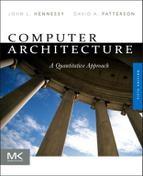H
Hadoop, WSC batch processing, 437
Half words
aligned/misaligned addresses, A-8
memory address interpretation, A-7 to A-8
MIPS data types, A-34
operand sizes/types, 12
as operand type, A-13 to A-14
Hard drive, power consumption, 63
Hardware
as architecture component, 15
cache optimization, 96
energy/performance fallacies, 56
pipeline hazard detection, C-38
Virtual Machines protection, 108
WSC cost-performance, 474
WSC running service, 434–435
Hardware-based speculation
basic algorithm, 191
data flow execution, 184
FP unit using Tomasulo’s algorithm, 185
ILP
data flow execution, 184
with dynamic scheduling and multiple issue, 197–202
FP unit using Tomasulo’s algorithm, 185
key ideas, 183–184
multiple-issue processors, 198
reorder buffer, 184–192
vs. software speculation, 221–222
key ideas, 183–184
Hardware prefetching
cache optimization, 131–133
miss penalty/rate reduction, 91–92
NVIDIA GPU Memory structures, 305
SPEC benchmarks, 92
Hazards See also Data hazards
detection, hardware, C-38
dynamically scheduled pipelines, C-70 to C-71
execution sequences, C-80
instruction set complications, C-50
longer latency pipelines, C-54 to C-58
HCAs See Host channel adapters (HCAs)
Heap, and compiler technology, A-27 to A-28
Heterogeneous architecture, definition, 262
Hewlett-Packard ProLiant SL2x170z G6, SPECPower benchmarks, 463
High-level optimizations, compilers, A-26
Highly parallel memory systems, case studies, 133–136
High-order functions, control flow instruction addressing modes, A-18
High-performance computing (HPC)
write strategy, B-10
History file, precise exceptions, C-59
Hit time
average memory access time, B-16 to B-17
first-level caches, 79–80
memory hierarchy basics, 77–78
way prediction, 81–82
HOL See Head-of-line blocking (HOL)
Home node, directory-based cache coherence protocol basics, 382
HPC See High-performance computing (HPC)
Hypertransport, AMD Opteron cache coherence, 361
Hypervisor, characteristics, 108
..................Content has been hidden....................
You can't read the all page of ebook, please click here login for view all page.
